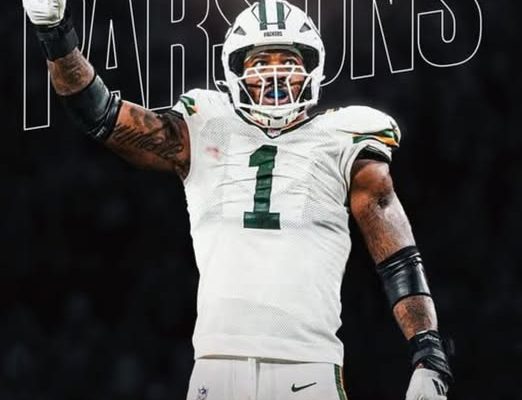Micah Parsons’ arrival in Green Bay has been nothing short of electrifying. After two games in the green and gold, the 26-year-old edge rusher has already positioned himself as the defensive centerpiece in Jeff Hafley’s new-look unit. Despite being on a managed snap count, Parsons has managed to produce the kind of disruptive impact that changes games and validates the Packers’ investment in him. Through 77 defensive snaps, Parsons has put up elite-level production: a 90.2 pass-rush grade, 10 total pressures, 1.5 sacks, four quarterback hits, one tackle for loss, and a pass-rush win rate of 25%. For a player still acclimating to his role in a new defense, the results suggest that he’s barely scratched the surface of what he can do in this scheme.
The most striking element of Parsons’ early tenure with the Packers is his efficiency. He hasn’t been on the field for every defensive snap, but when he is, opposing quarterbacks have felt his presence immediately. A pass-rush grade of 90.2 through just two games puts him among the league’s most effective disruptors, the type of player offensive coordinators have to game plan around on every down. His 10 total pressures might not seem gaudy in isolation, but when extrapolated to his snap count, it paints the picture of a defender winning consistently, creating havoc even when he doesn’t finish the play himself. Pressure doesn’t always show up on the stat sheet as a sack, but it forces hurried throws, missed reads, and sometimes dictates the tempo of an entire offensive possession. Parsons has already established himself as the kind of player who forces mistakes just by being on the field.
At 26, Parsons is in the prime of his career, and his hunger for dominance is palpable. His quote after Thursday’s game revealed both his competitive edge and his frustration at being held back: “I just want to be unleashed. Honestly, it frustrates me. I tell them it does more harm than good because I start getting tight. Hopefully, they take the leash off. You can’t hold a dog back forever.” That statement resonates with the intensity he brings every snap, a player who thrives on rhythm, flow, and sheer relentlessness. For Hafley and the Packers’ coaching staff, the challenge lies in balancing Parsons’ desire for more playing time with the need to manage his workload over the long grind of a season. But if his production per snap is any indication, giving him a fuller workload could unlock a Defensive Player of the Year campaign waiting to happen.
What’s remarkable is how quickly Parsons has adapted to Hafley’s system. Known for his aggressive, attacking philosophy, Hafley’s scheme seems tailor-made for Parsons’ skill set. He isn’t just rushing the passer; he’s setting edges, dropping back when needed, and showing the versatility that made him a star in Dallas before arriving in Green Bay. His tackle for loss reflects his ability to disrupt the run game, while his quarterback hits underline the consistency with which he gets home, even when the ball is released just in time. Hafley appears to trust Parsons to freelance within the structure of the defense, creating mismatches by moving him around and forcing offensive lines to guess where he’s coming from. Through two games, that unpredictability has been one of the Packers’ biggest assets.
The broader context of Parsons’ arrival can’t be ignored either. Green Bay’s defense has often lived in the shadow of its offense, defined by Aaron Rodgers for over a decade and now transitioning into the Jordan Love era. Parsons represents a new identity for the team, one built on defensive ferocity and game-changing plays from the front seven. His presence raises the ceiling for everyone around him. Fellow pass rushers and defensive linemen benefit from the double-teams he draws, while the secondary gets more opportunities to capitalize on hurried passes. In just two games, Parsons has already elevated the collective performance of the unit, giving Green Bay a defense that feels capable of dictating games rather than merely reacting.
It’s also worth noting the timing of Parsons’ surge. At 26, he’s no longer the promising young star trying to prove himself. He’s entering the stretch where the best defensive players consolidate their dominance and begin to define eras. Players like Aaron Donald, J.J. Watt, and Khalil Mack all had stretches where they weren’t just stars, but the players offenses feared the most. Parsons is trending toward that echelon. His numbers through two games put him on pace for a career year, and if the leash is indeed loosened, his production could jump from impressive to historic. A 25% pass-rush win rate is elite by any standard; to sustain that across a season would place him among the very best defensive disruptors of the modern era.
The question now is whether this will be the year Parsons finally captures his first Defensive Player of the Year award. He’s been in the conversation before, consistently hovering near the top of discussions, but something has always stood in the way—whether it was injuries, competition from other elite defenders, or the limitations of his previous team’s scheme. In Green Bay, the narrative might finally align with his production. The Packers’ defense has the pieces to support him, Hafley’s scheme gives him the freedom to shine, and his numbers are already suggesting dominance. Awards often come down to both performance and storylines, and Parsons has both working in his favor. He’s the new face of a proud franchise, a generational talent stepping into a role that could redefine the Packers’ defensive identity for years to come.
Of course, two games do not make a season, and Parsons himself knows this. The grind of the NFL is relentless, and sustaining elite play requires durability, consistency, and focus. His frustration about limited snaps also highlights the delicate balance between maximizing impact and preserving longevity. But that frustration also signals something important: Parsons doesn’t just want to be good; he wants to be great. He doesn’t measure himself by the stats alone but by the havoc he wreaks on every play. That mentality is what separates the very best defenders from the rest. It’s not about being satisfied with pressures or a handful of sacks—it’s about changing games, controlling outcomes, and instilling fear in opposing quarterbacks.
The Packers’ decision to manage his workload early may turn out to be a long-term benefit. By keeping him fresh, Hafley ensures Parsons is healthy for the stretch run when awards are decided, playoff pushes are made, and legends are written. But if Parsons keeps pressing the case that holding him back does “more harm than good,” Green Bay may have no choice but to unleash him fully. The next month will be telling, as the Packers face a mix of high-powered offenses and physical running games that will test their defensive resolve. Parsons will be at the center of those matchups, the player everyone will watch to see if he can tilt the field in Green Bay’s favor.
Looking at the broader picture, Parsons’ fit in Green Bay feels almost inevitable. His intensity aligns with the city’s gritty, blue-collar identity, a place that reveres defense as much as offense. Lambeau Field has seen its share of defensive icons, but Parsons has a chance to carve out a legacy unique to him, blending his modern versatility with the old-school ferocity the franchise has long valued. Fans have already embraced him, and as his impact grows, so will the expectations. But Parsons seems built for that pressure. His demand to be “unleashed” isn’t just about snaps—it’s about legacy, about fulfilling the destiny of being one of the greats of his generation.
Through two appearances as a Green Bay Packer, Micah Parsons has been everything the team hoped for and more. The stats—90.2 pass-rush grade, 10 pressures, 1.5 sacks, 25% win rate—tell part of the story, but the real impact goes beyond numbers. It’s in the way he changes protections, the way he commands attention, and the way his teammates feed off his energy. At just 26 years old, Parsons is poised to define the next era of Green Bay football. Whether this is the year he finally captures the Defensive Player of the Year award remains to be seen, but if his first two games are any indication, the rest of the league should be on notice. The Packers have unleashed a game-wrecker, and once the leash is truly off, there may be no stopping him.



